Introduction
- During the past 30 years health care costs in the United States have risen from 4 to 14 percent (Fries, et al., 1993).
- Improvement of health care services while ensuring low costs requires the following measure taken:
- High-cost pharmaceutical management;
- Management of chronic care;
- Management of drop-in appointments;
- Primary prevention;
- Health maintenance;
- Hospital contracting;
- Medical error reduction (Leatherman, et al., 2003).
The Quality Initiative
The Quality Initiative was inaugurated by the Medicare and Medicaid health care services in 2001 and launched nationally in 2002 encompassing nursing homes, hospitals, physicians, home health care providers and other health services in an effort to improve health care and lower costs (Sultz & Young, 2008).
Programs in the Quality Initiative
- Quality Monitoring to collect, analyze and interpret data to improve the quality of health care given to its benefactors.
- Pay for Performance a system which rewards doctors, hospitals and health care providers for their efficiency.
- The Hospital Compare Website. A website which tracks the performance of hospitals based on 4 common conditions and 20 criteria.
- Non payment for Hospital acquired infections and reductions in treatment payment for problematic hospital events (Sultz & Young, 2008).
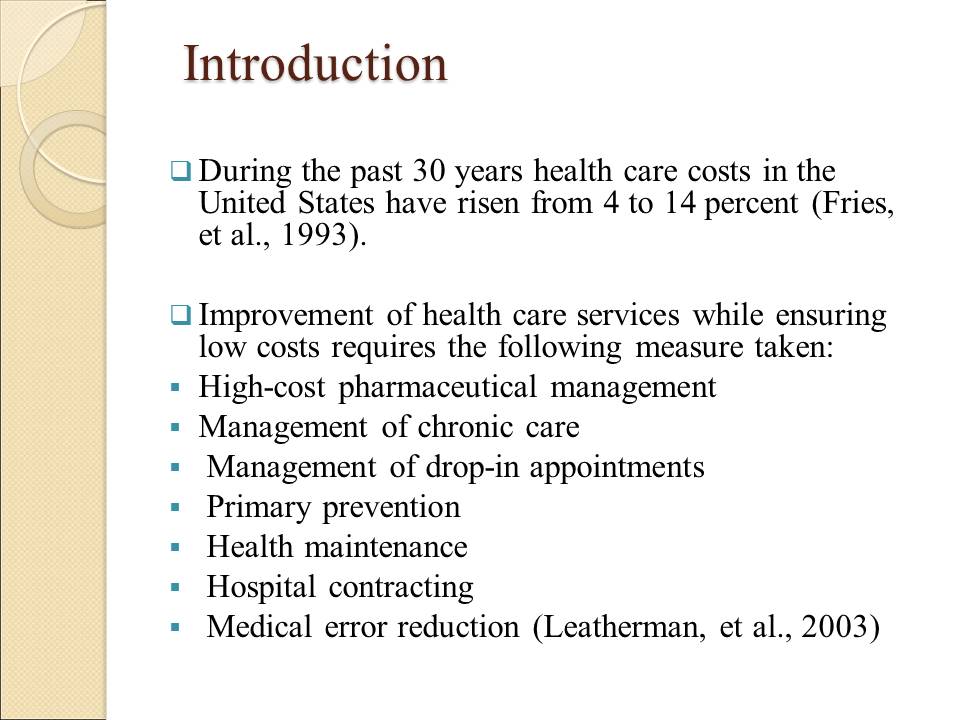

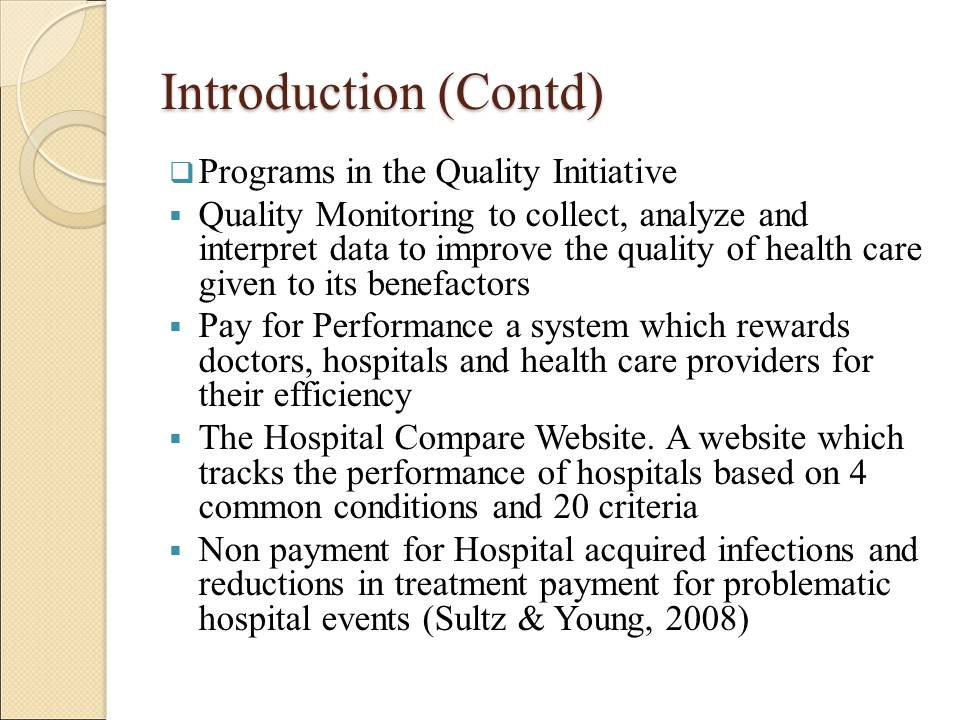
Objective of the Initiative
- To encourage hospitals and health care providers to improve the quality of health care.
- To create incentives for the improvement of healthcare and support public accountability.
- To work with other health care organizations to set the standards of hospital quality measures and voluntary reporting.
- To ensure ongoing regulation by state surveying agencies.
- Rewards for performance and continued improvement through community interactions and increase in knowledge and resources (Centers for Medicare and Medicaid Services, 2005).
- Ensure that the quality initiative meets the following ethical requirements:
- Justify the costs and risks of investment in terms of health care;
- Structured to achieve its goals;
- Fairly distribute responsibilities and burdens;
- Limit risks and maximize benefits;
- Respect the patients and ensure they are informed of the risks of receiving this form of health care so that they can make informed decisions and ensure accountability (Lynn, et al., 2007).
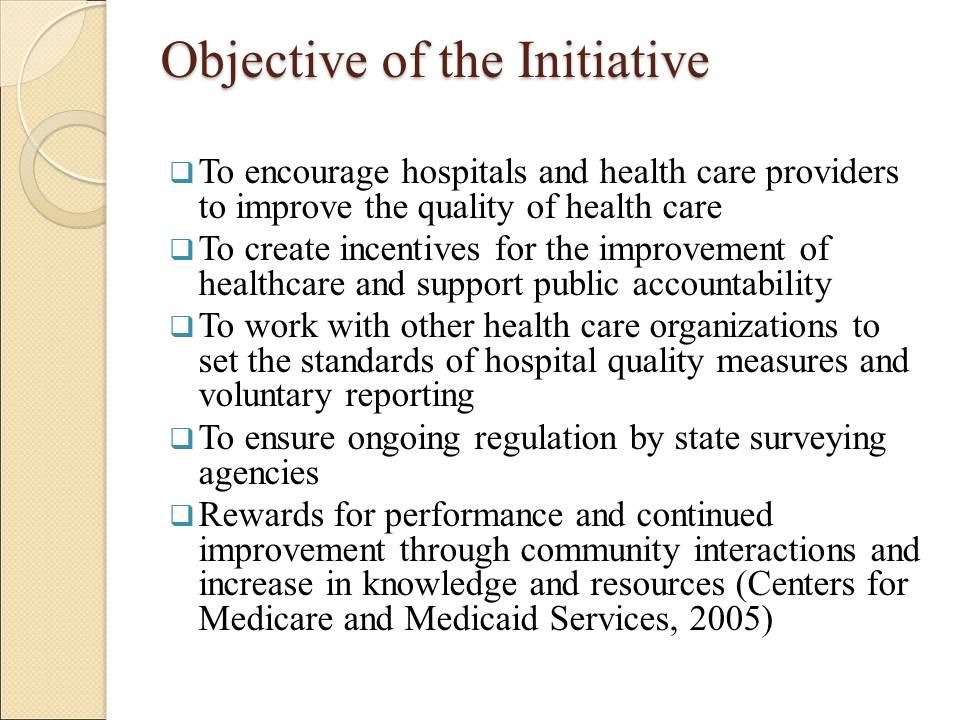

Impact on health care organizations
- A study was taken and calculated to predict average costs for 3,794 hospitals in the United States in 2009.
- There is a relationship between the lower risk adjusted costs and low nurse ratio in hospitals with increased profits and larger number of Medicare beneficiaries.
- The number of hospitals exhibiting low costs also exhibited low performance in the treatment of acute myocardial infarction and chronic heart failure (Jha, Orav, Dobson, Book, & Epstein, 2009).
- The 30 day mortality rates were comparable for high cost and low cost hospitals in terms of Acute Myocardial Infarction and Pneumonia.
- There is no evidence that low cost hospitals provide a better level of care. In fact they had slightly worse performance according to pre decided quality based indicators (Jha, Orav, Dobson, Book, & Epstein, 2009).
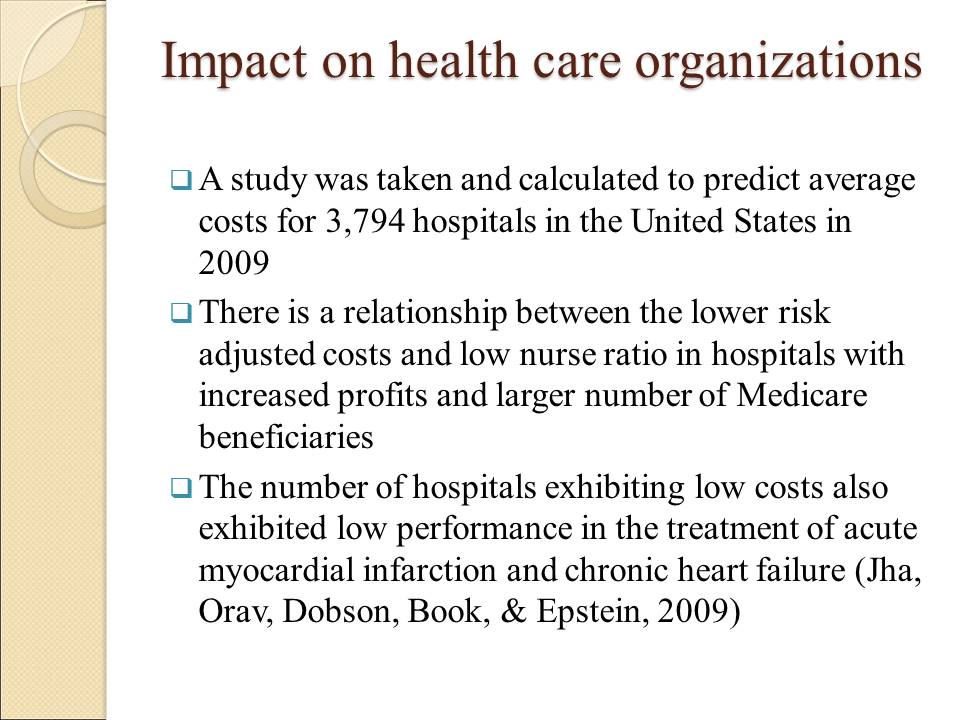
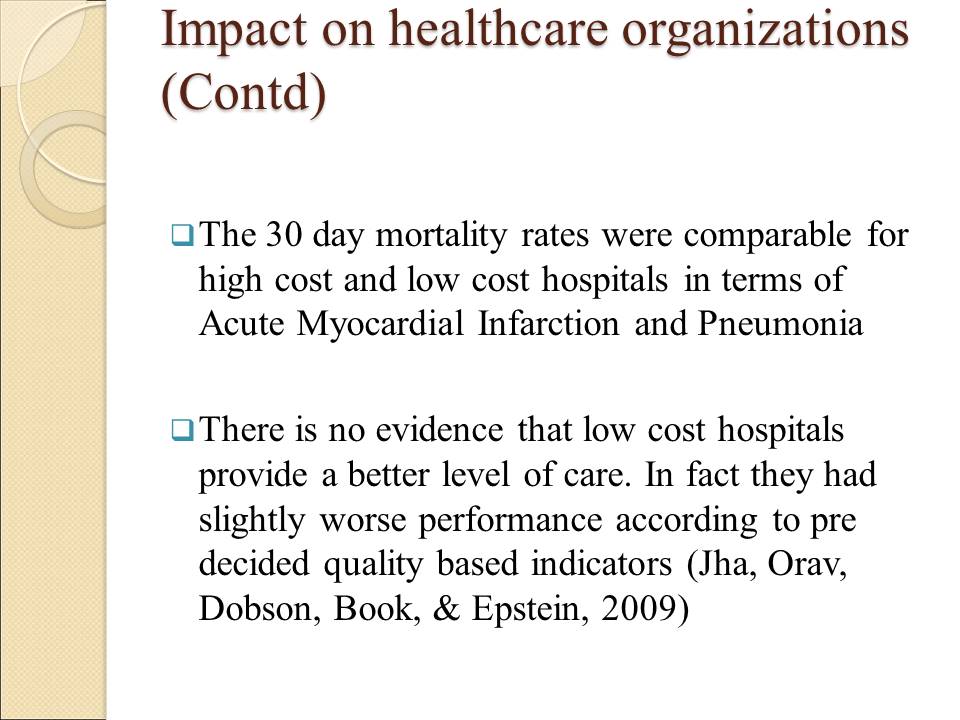
Discussion of Success/failure
Studies conducted on the pay for performance improvement in medical care found the following results:
- Nursing homes with caring for patients with debilitating and chronic conditions showed profits and improved health.
- In nine studies on health provider groups they found that the use of financial incentives improves health care in two studies. With five others showing a partial improvement
- In terms of individual physicians five of six studies showed positive effects.
- The incentive is causing the restriction of care for the most severely ill patients thus causing improvements in documentation rather than actual health care (Laura A. Petersen, LeChauncy D. Woodard, Tracy Urech, Christina Daw, & Supicha Sookanan, 2006 ).
- The centers for Medicaid and Medicare estimated that hospital costs increased in 2007 by 7.3% (Jha, Orav, Dobson, Book, & Epstein, 2009).
- Costs of hospital increase are not improving quality of patient care.
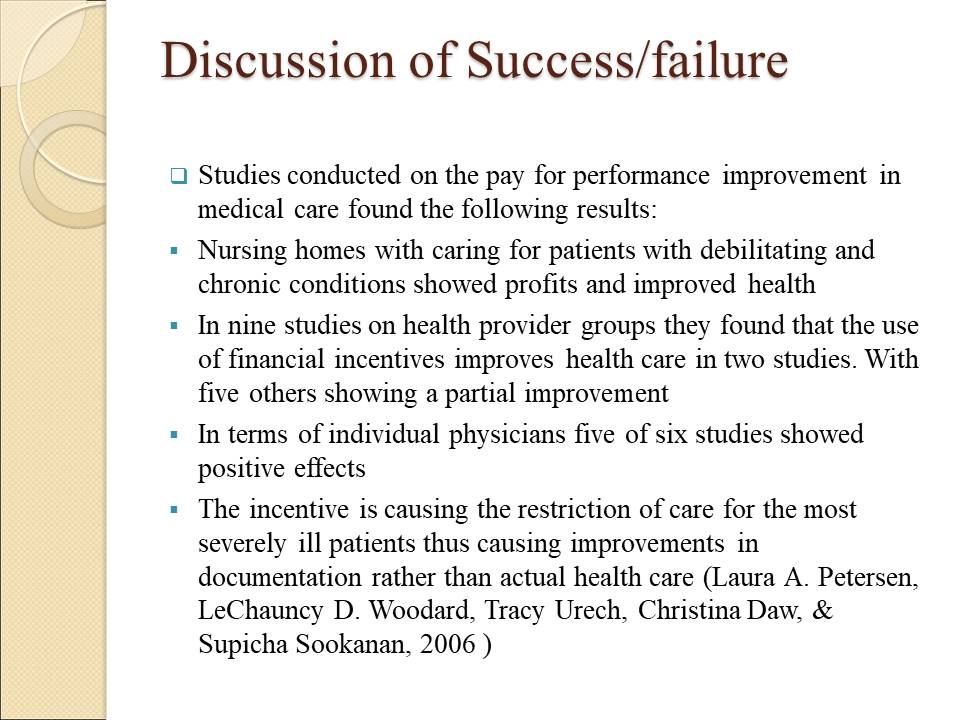

Summary/Conclusion
- The implementation of Quality Initiative has brought no improvement to the health care industry or rising health care costs.
- Low cost and high profit institutions show no increased benefits in health care.
- There are however partial or positive effects related to the Pay for Performance program (Gemmil, 2007).
- Better Solutions are needed to reduce the demand for medical services. Implementation of the following solutions may reduce the potential demand among the population.
- Primary Prevention to ensure better health habits.
- Bridging the difference in cost between various services.
- Enabling patients to self manage.
- Promotion of healthy lifestyle in the workplace.
- Cost cutting measures for terminal illnesses (Fries, et al., 1993).
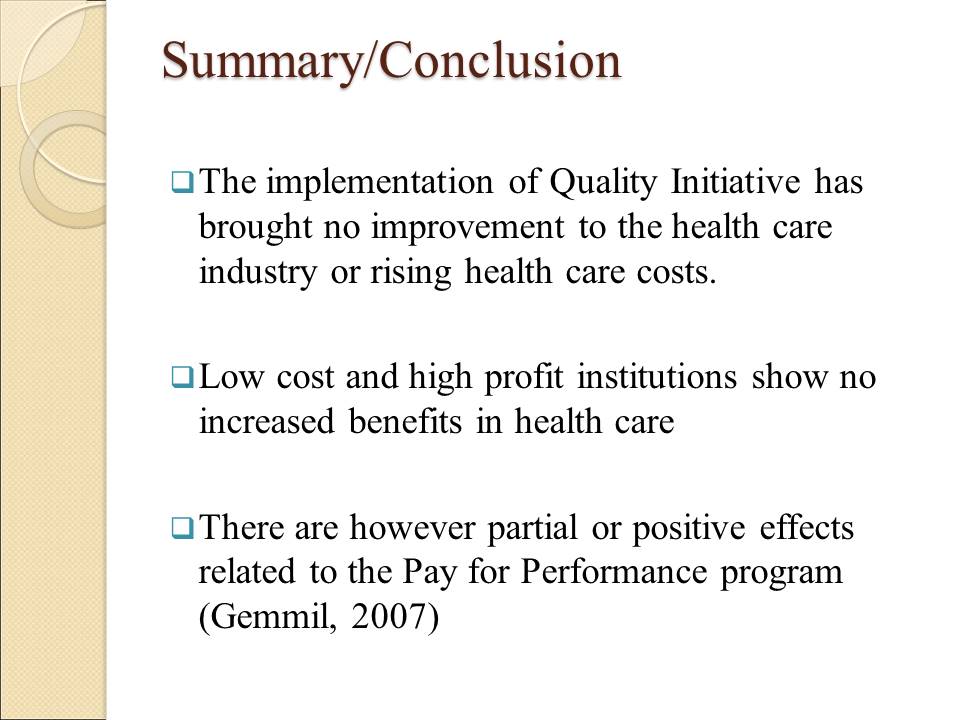
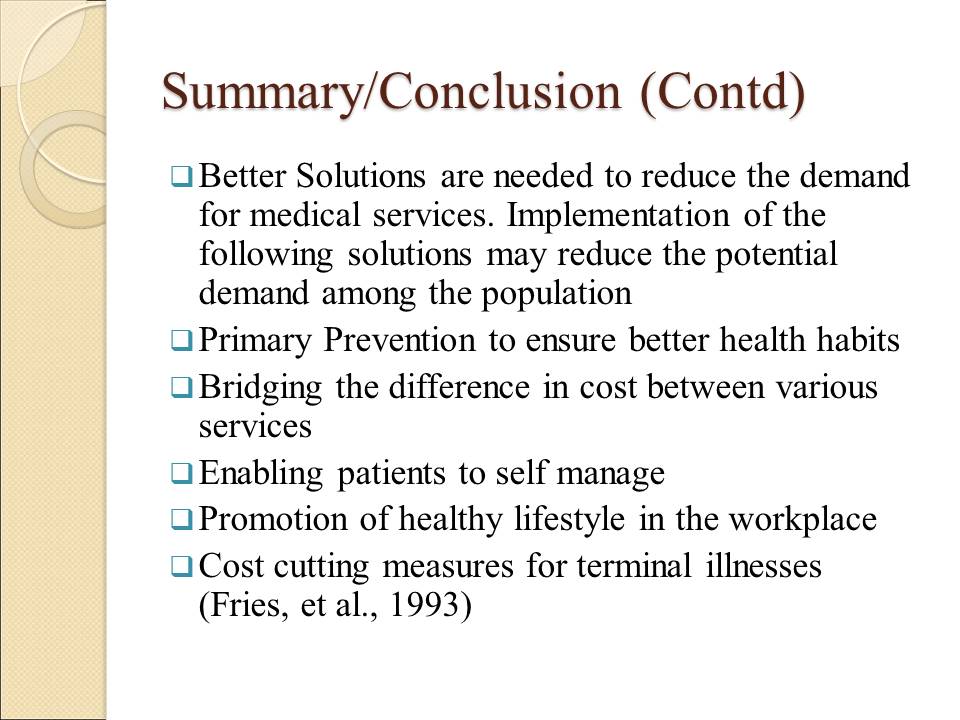
References
Centers for Medicare and Medicaid Services. (2005). Hospital Quality Initiative Overview. Web.
Fries, J. F., Koop, C. E., Beadle, C. E., Cooper, P. P., England, M. J., Greaves, R. F., et al. (1993). Reducing Health Care Costs by Reducing the Need and Demand for Medical Services. The New England Journal Of Medicine Volume 329 Issue 5 , 321-325.
Gemmil, M. (2007). Pay for Performance In the US: What Lessons for Europe. Eurohealth Volume 13 Issue 4 , 21-23.
Jha, A. K., Orav, E. J., Dobson, A., Book, R. A., & Epstein, A. M. (2009). Measuring Efficiency: The Association Of Hospital Costs And Quality Of Care. Health Affairs Volume 28 Issue 3 , 897-906.
Laura A. Petersen, M. M., LeChauncy D. Woodard, M. M., Tracy Urech, B., Christina Daw, M., & Supicha Sookanan, M. (2006 ). Does Pay-for-Performance Improve the Quality of Health Care? . Annals Of Internal Medicine Volume 145 Issue 4 , 265-272.
Leatherman, S., Berwick, D., Iles, D., Lewin, L. S., Davidoff, F., Nolan, T., et al. (2003). The Business Case For Quality: Case Studies And An Analysis. Health Affairs Volume 22 Issue 2 , 17-30.
Lynn, J., Baily, M. A., Bottrell, M., Jennings, B., Levine, R. J., Davidoff, F., et al. (2007). The Ethics of Using Quality Improvement Methods in Health Care. Annals of Internal Medicine Volume 146 Issue 9 , 666-673.
Sultz, H. A., & Young, K. M. (2008). Health Care USA p. 267-268. Massachusetts: Jones & Bartlett Publishers.